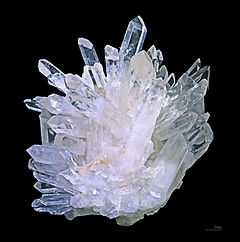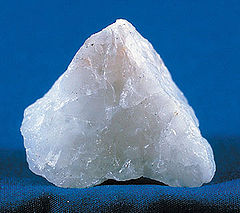
Back Kwarts Afrikaans Cuarz AN क्वार्टज़ ANP مرو (معدن) Arabic Cuarzu AST Kvars Azerbaijani Кварц Byelorussian Кварц BE-X-OLD Кварц Bulgarian क्वार्ट्ज Bihari


Quartz is a tectosilicate mineral that is the second most common mineral in Earth's continental crust.[1] Its crystal structure is a framework of SiO4 silicon–oxygen tetrahedra. Each shares an oxygen atom with another tetrahedron, so the overall chemical formula is SiO2 or silica.
Its name is derived from the German quarz, which sounds the same but is spelled without a t.
There are many different varieties of quartz, some of which are semi-precious gemstones. They have been used for a long time to make jewelry and hardstone carvings. Agate, amethyst, rose quartz are all forms of quartz.
Quartz crystals are used in oscillators, for example in quartz clocks. People also extract the silicon to make semiconductors. The majority of sand is small quartz bits. Quartz has a mineral hardness of 7. (mohs scale).
The word "quartz" comes from the German word "quarz".[2]
'Fused quartz' is glass made of silica in non-crystalline form. It does not contain other ingredients that are added to other glass to lower the melting point. Fused silica has high working and melting temperatures. For some purposes, fused quartz is better than other types of glass due to its purity. The glass is used in a number of high-tech products.[3]
Quartz comes in many different types such as clear quartz, smoky quartz, tiger's eye, lemon quartz and many more. There are many microcrystalline types of quartz, like Jasper, Onyx, Agate and Carnelian.
- ↑ The most common mineral is feldspar.
- ↑ http://www.etymonline.com/index.php?term=quartz etymonline.com
- ↑ De Jong, Bernard; Beerkens, Ruud & Van Nijnatten, Peter 2000. (2000). "Glass". Ullmann's Encyclopedia of Industrial Chemistry. doi:10.1002/14356007.a12_365. ISBN 3-527-30673-0.
{{cite book}}: CS1 maint: multiple names: authors list (link) CS1 maint: numeric names: authors list (link)